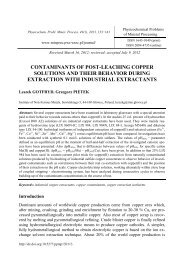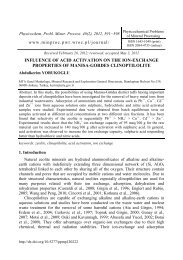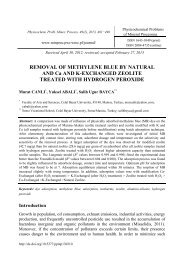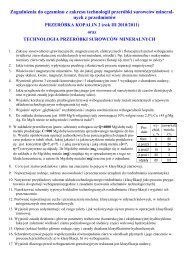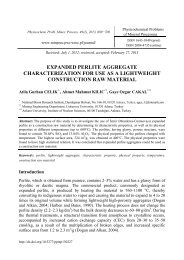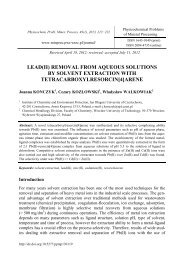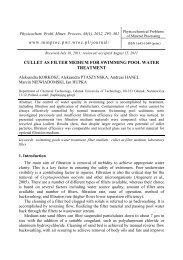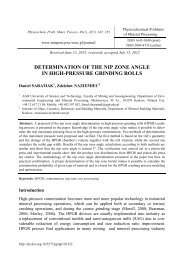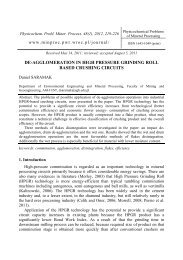Wetting of supports by ionic liquids used in gas separation processes
Wetting of supports by ionic liquids used in gas separation processes
Wetting of supports by ionic liquids used in gas separation processes
You also want an ePaper? Increase the reach of your titles
YUMPU automatically turns print PDFs into web optimized ePapers that Google loves.
130 M. Joskowska et al.concentration <strong>in</strong> organic phase is also important <strong>in</strong> SLMs stability, whereas when it isless than 15 g/l it shows proper stability (Zha et al., 1995).In recent years <strong>ionic</strong> <strong>liquids</strong> have been widely <strong>used</strong> as an alternative to traditionalorganic solvents <strong>in</strong> catalysis, as a reaction media and <strong>in</strong> <strong>separation</strong> and purification<strong>processes</strong>. Ionic <strong>liquids</strong> have many unique properties, for example, they have nonmeasureablevapor pressure, they are non-flammable and liquid <strong>in</strong> a wide range <strong>of</strong>temperatures, they solvate wide range <strong>of</strong> organic and <strong>in</strong>organic species (Earle et al.,2000; Marsh et al. 2004; Pernak, 2000). Ionic <strong>liquids</strong> give a possibility <strong>of</strong> adjust<strong>in</strong>gtheir physicochemical properties <strong>by</strong> choos<strong>in</strong>g proper ions. Proper choice <strong>of</strong> organicphase allows to avoid the problem <strong>of</strong> solvat<strong>in</strong>g IL <strong>in</strong> receiv<strong>in</strong>g phase and only theexcess amount <strong>of</strong> ILs from the membrane surface is removed (De Los Rios, 2007;2009). These properties give SILMs advantage over traditional SLMs (Fortunato et al.2004; Gan et al, 2006; Hernandez-Fernandez et al., 2009). Non-measurable vaporpressure allows to overcome the problem with loss <strong>of</strong> membrane phase <strong>by</strong>evaporation. S<strong>in</strong>ce ILs consist <strong>of</strong> large asymmetric organic cation and small anion andthis structure prevents crystallization, they are liquid <strong>in</strong> a wide range <strong>of</strong> temperatures.As mentioned above, stability depends on capillary forces that is why size andmorphology <strong>of</strong> membrane pores affect the stability (Kemperman et al., 1996).M<strong>in</strong>imum transmembrane pressure required to push out the impregnat<strong>in</strong>g phase frommembrane pores is given <strong>by</strong> the Young–Laplace equation:2 cosP , (1)rwhere:γ is the <strong>in</strong>terfacial tension, θ is the contact angle, r is the pore radius.This equation is true for cyl<strong>in</strong>drical pores. Commercially available membraneshave highly irregular pores geometry. Calculated pressure is then higher than realcritical level. It can be concluded that generally membranes with smaller pore size aremore stable than those with bigger pores.This work foc<strong>used</strong> on the use <strong>of</strong> polymeric porous membranes which can beapplied as support for liquid membranes. Experimental procedures based on capillaryrise method are widely <strong>used</strong> for porous media characterization (i.e. pore radius,contact angle). Measurements <strong>of</strong> penetration distance and liquid mass <strong>in</strong>crease are twoma<strong>in</strong> experimental methods, <strong>in</strong> which Washburn equation is a basic <strong>in</strong>strument toanalyze the obta<strong>in</strong>ed results (Trong et al., 2005; 2006). Capillary rise method was <strong>used</strong>for contact angle determ<strong>in</strong>ation for polymeric material wetted <strong>by</strong> <strong>ionic</strong> <strong>liquids</strong>.Influence <strong>of</strong> imidazolium-based <strong>ionic</strong> <strong>liquids</strong> composition on wettability <strong>of</strong> porous<strong>supports</strong> was <strong>in</strong>vestigated. The family <strong>of</strong> 1-alkyl-3-methylimidazolium compounds(C n mim) with variable alkyl cha<strong>in</strong> lengths <strong>in</strong> cation and changeable anions were taken<strong>in</strong>to account.
<strong>Wett<strong>in</strong>g</strong> <strong>of</strong> <strong>supports</strong> <strong>by</strong> <strong>ionic</strong> <strong>liquids</strong> <strong>used</strong> <strong>in</strong> <strong>gas</strong> <strong>separation</strong> <strong>processes</strong> 1312. Experimental2.1. Material, experimental apparatus and methodSeven <strong>ionic</strong> <strong>liquids</strong> were <strong>used</strong> <strong>in</strong> this study: 1-ethyl-3-methylimidazoliumbis(trifluoromethylsulfonyl)imide [EMIM][Tf2N], 1-ethyl-3 methylimidazoliumtrifluoromethanesulfone [EMIM][TfO], 1-butyl-3-methylimidazolium bis(trifluoromethylsulfonyl)imide [BMIM][Tf2N], 1-butyl-3-methylimidazolium trifluoromethanesulfone [BMIM][TfO]. All chemicals were supplied <strong>by</strong> Merck ChemicalsCompany, Darmstadt, Germany with purity higher than 99%. The molecular structures<strong>of</strong> ILs cations and anions <strong>used</strong> <strong>in</strong> this study are shown <strong>in</strong> Fig.1 and Fig.2.In order to determ<strong>in</strong>e the effect <strong>of</strong> chemical structure <strong>of</strong> the <strong>ionic</strong> <strong>liquids</strong> onwett<strong>in</strong>g, different alkyl cha<strong>in</strong> lengths <strong>of</strong> the cations and different anions were selected.Polymeric <strong>supports</strong>: the four hydrophilic membranes were <strong>used</strong>: GH Polypro(polypropylene) - PP, FP Vericel TM (polyv<strong>in</strong>ylidene fluoride) - PVDF, Nylaflo TM(polyamide) - Nylon, Supor ® (polyethersulfone) - PES, (Pall, Gelman Laboratory,USA). Table 1 shows the physicochemical properties <strong>of</strong> polymeric <strong>supports</strong> <strong>used</strong> <strong>in</strong>the experiments declared <strong>by</strong> Pall, Gelman Laboratory.N+NN+N1-ethyl-3-methylimidazolium [Emim]1-butyl-3-methylimidazolium [Bmim]Fig. 1. Structure <strong>of</strong> <strong>ionic</strong> <strong>liquids</strong> cations <strong>used</strong> <strong>in</strong> the experimentsF FFF-NFS SFOOO Obis(trifluoromethylsulfonyl)imide [Tf 2 N]SupportFFFOSO-Otrifluoromethanesulfone [TfO]Fig. 2. Structure <strong>of</strong> <strong>ionic</strong> <strong>liquids</strong> anions <strong>used</strong> <strong>in</strong> the experimentsTable 1. Physicochemical parameters <strong>of</strong> polymeric <strong>supports</strong> reported <strong>by</strong> producerDensity[kg/m 3 ]Pore size[µm]Porosity[%]Thickness[µm]PP 900 0.2 80 92PVDF 1790 0.2 80 123Nylon 1130 0.2 80 110PES 1370-1510 0.2 80 148
<strong>Wett<strong>in</strong>g</strong> <strong>of</strong> <strong>supports</strong> <strong>by</strong> <strong>ionic</strong> <strong>liquids</strong> <strong>used</strong> <strong>in</strong> <strong>gas</strong> <strong>separation</strong> <strong>processes</strong> 133One way <strong>of</strong> determ<strong>in</strong><strong>in</strong>g contact angle value is an <strong>in</strong>vestigation <strong>of</strong> two <strong>liquids</strong> –reference and exam<strong>in</strong>ed (Studebaker, 1955). For reference liquid:hr2 0 t0.20When two beds are identical, r is constant, and for another liquid we have:Divid<strong>in</strong>g equation (4) <strong>by</strong> (5) we obta<strong>in</strong>:wherehrcos2 1 t1.21cost0 K ,t11 0 1K , 1 01wheret 0 , γ 0 , η 0 are time <strong>of</strong> penetration, surface tension and viscosity <strong>of</strong> reference liquid, andt 1 , γ 1 , η 1 are time <strong>of</strong> penetration, surface tension and viscosity <strong>of</strong> liquid <strong>in</strong>vestigated,respectively.The apparatus for the capillary rise experiments is shown <strong>in</strong> Fig. 3.(4)(5)(6)(7)Fig. 3. Capillary rise measur<strong>in</strong>g apparatus: 1 - support, 2 – glass matrix holder , 3 – polymeric membrane,4 – vessel with <strong>ionic</strong> liquid, 5 - balance, 6 -computer
134 M. Joskowska et al.In the experiment, polymeric membrane samples sized 10x10 mm were cut out.The l<strong>in</strong>e at 5 mm height was made. The sample was placed <strong>in</strong> a glass holder. The<strong>in</strong>crease <strong>in</strong> height <strong>of</strong> liquid penetrat<strong>in</strong>g <strong>in</strong>to polymeric membrane and decrease <strong>in</strong> mass<strong>of</strong> the liquid <strong>in</strong> a conta<strong>in</strong>er was recorded every second us<strong>in</strong>g timer and electronicbalance, attached to a computer. The time t = 0 approximately corresponded to themoment <strong>of</strong> membrane submersion <strong>in</strong> the wett<strong>in</strong>g liquid. The time <strong>of</strong> penetration up to5 mm <strong>of</strong> membrane was measured. The experiments were repeated eight times (twotimes for each side) and the mean value was calculated. Based on measurement <strong>of</strong><strong>ionic</strong> liquid penetration time <strong>in</strong> polymeric support, angle values were calculated us<strong>in</strong>gEquations 5 and 6. The results are shown <strong>in</strong> Table 2.The second method for contact angle determ<strong>in</strong>ation was the dynamic sessile dropmethod. The surface tensions <strong>of</strong> the <strong>ionic</strong> <strong>liquids</strong> were determ<strong>in</strong>ed <strong>by</strong> the pendant dropmethod us<strong>in</strong>g Tensiometer Kruss DSA 10. Dynamic sessile drop study determ<strong>in</strong>es thelargest contact angle possible without <strong>in</strong>creas<strong>in</strong>g solid/liquid <strong>in</strong>terfacial area <strong>by</strong> add<strong>in</strong>gvolume <strong>of</strong> liquid dynamically. This maximum angle is the advanc<strong>in</strong>g angle a .Volume is removed to produce the smallest possible angle, the reced<strong>in</strong>g angle r . Thedifference between the advanc<strong>in</strong>g and reced<strong>in</strong>g angle a - r is the contact anglehysteresis. The results are shown <strong>in</strong> Table 3.3. Results and discussionIn the experiments imidazolium <strong>ionic</strong> <strong>liquids</strong> with different anions and cationswere applied. Selected <strong>ionic</strong> <strong>liquids</strong> are widely <strong>used</strong> <strong>in</strong> <strong>gas</strong> <strong>separation</strong> technology.Imidazolium salts conta<strong>in</strong><strong>in</strong>g alkyl fluoride anions: bis(trifluoromethanesulfonyl)amide ([Tf 2 N]) and trifluoromethanesulfonate ([TfO]) selectively separate carbon (IV)oxide from other <strong>gas</strong>es, for example methane (Anderson et al., 2007; Anthony et al.,2005; Baltus et al., 2004; Bara et al., 2009; Bates et al., 2002; Ch<strong>in</strong> et al., 2006;Joskowska et al., 2010; Joskowska et al. 2011).The morphology <strong>of</strong> commercial membranes was studied <strong>by</strong> SEM. SEM (Fig.4)micrographs present highly porous material. The pores are heterogenic and notcyl<strong>in</strong>drical.Figure 4 <strong>in</strong>dicates, that the 0.2 μm pore size declared <strong>by</strong> the manufacturer is not thesize <strong>of</strong> the smallest pores, but the average size <strong>of</strong> all the pores <strong>in</strong> the membranes.IR spectra illustrate <strong>in</strong>tense stretch<strong>in</strong>g vibrations <strong>of</strong> C-H bond - methyl group at2951 cm -1 (asymmetric) and 2868 cm -1 (symmetric) and methylene group at 2919 cm -1(asymmetric) and 2839 cm -1 (symmetric) are visible <strong>in</strong> the IR spectra <strong>of</strong> PP membrane(Fig. 5). Stretch<strong>in</strong>g vibrations <strong>of</strong> the double bond occurred at 1728 cm -1 . IR spectrashows also <strong>in</strong>tense bend<strong>in</strong>g vibrations <strong>of</strong> symmetric methylene group at 1453 cm -1and bend<strong>in</strong>g vibrations <strong>of</strong> asymmetric methyl groups at 1376 and 1358 cm -1 .Therefore, it can be concluded that the surface <strong>of</strong> PP membrane is modified withcompounds conta<strong>in</strong><strong>in</strong>g C-O-C bonds, as evidenced <strong>by</strong> the emergence <strong>of</strong> asymmetricstretch<strong>in</strong>g vibration <strong>of</strong> C-O-C bond at 1256 cm -1 and asymmetric at 1105 cm -1 band
<strong>Wett<strong>in</strong>g</strong> <strong>of</strong> <strong>supports</strong> <strong>by</strong> <strong>ionic</strong> <strong>liquids</strong> <strong>used</strong> <strong>in</strong> <strong>gas</strong> <strong>separation</strong> <strong>processes</strong> 137Capillary rise experiments were carried out <strong>in</strong> order to <strong>in</strong>vestigate wattablility <strong>of</strong>the polymeric support <strong>by</strong> selected <strong>ionic</strong> <strong>liquids</strong>. The first experiment <strong>in</strong>clud<strong>in</strong>g water,toluene, ethanol, methanol, isopropanol, acetone, hexane and cyclohexane was done <strong>in</strong>order to determ<strong>in</strong>e a reference wett<strong>in</strong>g liquid for each support. Methanol was the bestpenetrat<strong>in</strong>g liquid for PP, hexane for PES and PVDF. For Nylon membrane toluene(see table 2) occurred to be the best. Based on the time <strong>of</strong> penetration <strong>in</strong> polymericmatrix measurements <strong>of</strong> reference <strong>liquids</strong> and exam<strong>in</strong>ed <strong>ionic</strong> <strong>liquids</strong>, contact anglesvalues were calculated (see table 3). For all the exam<strong>in</strong>ed <strong>ionic</strong> <strong>liquids</strong> wettabilitydecreases <strong>in</strong> follow<strong>in</strong>g order Nylon > PP (except for BMIM TfO) > PVDF > PES. Thelowest value <strong>of</strong> contact angles for all <strong>supports</strong> has been determ<strong>in</strong>ed for BMIM TfO.Contact angle, θ, <strong>in</strong>creases as the surface tension <strong>of</strong> the <strong>ionic</strong> liquid, γ <strong>in</strong>creases.Similar f<strong>in</strong>d<strong>in</strong>gs have been reported earlier <strong>by</strong> Sedev (2011).The Washburn equation presents l<strong>in</strong>ear dependence <strong>of</strong> squared height <strong>of</strong> liquidpenetration <strong>in</strong> capillary and time <strong>of</strong> the experiment. However, <strong>in</strong> the case <strong>of</strong> poroussystem, Washburn established the model <strong>of</strong> system as a bunch <strong>of</strong> cyl<strong>in</strong>dricalcapillaries. Capillary radius r is then the average or effective pores radius. Anothersimplification <strong>in</strong> Washburn method is connected with flow which should be lam<strong>in</strong>arand stationary and without flow <strong>in</strong> the phase boarder.Exam<strong>in</strong>ed polymer <strong>supports</strong> do not meet Washburn assumptions. Therefore, sessiledrop method was <strong>used</strong>.Values <strong>of</strong> contact angles calculated form sessile drop contact angle measurementsare below 20º, therefore all the <strong>ionic</strong> <strong>liquids</strong> exam<strong>in</strong>ed are suitable for perfect wett<strong>in</strong>g<strong>of</strong> <strong>supports</strong> (table 4). The best wettability was observed for Nylon membrane,successively for PP, PVDF and PES.Assumption <strong>of</strong> best wett<strong>in</strong>g for <strong>liquids</strong> with the lowest surface tension wasconfirmed ([Bmim][TfO]). Increase <strong>in</strong> <strong>ionic</strong> liquid hydrocarbon cha<strong>in</strong> <strong>in</strong> cationstructure does not affect wettability.Tak<strong>in</strong>g <strong>in</strong>to account values <strong>of</strong> contact angles (table 4) it can be concluded that each<strong>of</strong> chosen <strong>supports</strong> is perfectly wetted <strong>by</strong> <strong>ionic</strong> <strong>liquids</strong>.Izak et al. (2007) observed that degree <strong>of</strong> swell<strong>in</strong>g <strong>of</strong> the membrane can be relatedwith the water activity <strong>of</strong> the <strong>ionic</strong> liquid. The measured water content <strong>of</strong> <strong>ionic</strong> <strong>liquids</strong><strong>used</strong> was [Emim][TfO] – 1.370%, [Bmim][TfO] – 0.134%, [Emim][Tf 2 N] – 0.001%,[Bmim][Tf 2 N] – 0.109%. However, <strong>ionic</strong> <strong>liquids</strong> are highly hygroscopic and we haveto keep <strong>in</strong> m<strong>in</strong>d that water content can change dur<strong>in</strong>g the experiment (Izak et al.,2007).All the <strong>in</strong>vestigated <strong>supports</strong> show higher thickness after immobilization with <strong>ionic</strong>liquid. Accord<strong>in</strong>g to presented data it can be concluded that the longer is hydrocarboncha<strong>in</strong> <strong>in</strong> the cation structure, the higher swell<strong>in</strong>g effect is observed. However, Nylonmembrane shows similar thickness for all <strong>ionic</strong> <strong>liquids</strong> <strong>used</strong> <strong>in</strong> this study. Thickness <strong>of</strong>PVDF membrane was difficult to measure due to transparency <strong>of</strong> the membrane whenimmobilized with <strong>ionic</strong> liquid as <strong>in</strong>dicated <strong>by</strong> standard deviations values. Such
140 M. Joskowska et al.IZAK, P., HOVORKA, S., BARTOVSKY, T., BARTOVSKA, L., CRESPO, J.G., 2007, Swell<strong>in</strong>g <strong>of</strong>polymeric membranes <strong>in</strong> room temperature <strong>ionic</strong> <strong>liquids</strong>. J. Membr. Sci., 296, 131–138.JOSKOWSKA, M., DEBSKI, B., LUCZAK, J., MARKIEWICZ, M., ARANOWKI, R., HUPKA, J.,2010, Determ<strong>in</strong>ation <strong>of</strong> carbon dioxide diffusion coefficients <strong>in</strong> supported <strong>ionic</strong> <strong>liquids</strong> membranes.Przem. Chem., 89, 1189–1193.JOSKOWSKA, M., LUCZAK, J., ARANOWSKI, R., HUPKA, J., 2011, Use <strong>of</strong> imidazolium <strong>ionic</strong><strong>liquids</strong> for carbon dioxide <strong>separation</strong> from <strong>gas</strong> mixtures. Przem. Chem., 90, 174–180.KEMPERMAN, A.J.B., BOOMGAARD, D.B.T., STRATHMANN, H., 1996, Stability <strong>of</strong> SupportedLiquids Membranes: State <strong>of</strong> the Art. Sep. Purif. Techno., 31, 2733–2762.KOCHERGINSKY, N.M., LALITHA SEELAM, Q.Y., 2007, Recent advances <strong>in</strong> supported liquidmembrane technology. Sep. Purif. Techno., 53, 71–177.MARSH., K.N., BOXALL, J.A., LICHTENHALL, R., 2004, Room temperature <strong>ionic</strong> <strong>liquids</strong> and theirmixtures – a review. Fluid Phase Equilib., 219, 93–98.NAPLENBROEK, A.M., SMOLDERS, C.A., 1992, Supported liquid membranes: <strong>in</strong>stability effects. J.Membr. Sci., 67, 121–132.PERNAK, J., 2000, Ciecze jonowe – rozpuszczalniki XXI wieku. Przem. Chem., 79, 150–153.SEDEV, R., 2011, Surface tension, <strong>in</strong>terfacial tension and contact angles <strong>of</strong> <strong>ionic</strong> <strong>liquids</strong>. Curr. Op<strong>in</strong>.Colloid Interface Sci., article <strong>in</strong> press, doi:10.1016/j.cocis.2011.01.011.TAKEUCHI, H., TAKAHASHI, K., GOTO, W., 1897, Some observations on the stability <strong>of</strong> supportedliquid membranes. J. Membr. Sci., 34, 19–31.TRONG, D., HUPKA, J., 2005, Chatacterization <strong>of</strong> porous materials <strong>by</strong> capillary rise method.Physicochem. Probl. M<strong>in</strong>er. Process., 39, 47–65.TRONG, D., HUPKA, J., DRZYMALA, J., 2006, Imapact <strong>of</strong> roughness on hydrophobicity <strong>of</strong> particlesmeasured <strong>by</strong> the Washburn method. Physicochem. Probl. M<strong>in</strong>er. Process. 40, 45–52.ZHA, F.F., FANE, A.G., FELL, C.J.D., 1995, Instability mechanisms <strong>of</strong> supported liquid membranes <strong>in</strong>phenol transport process. J. Membr. Sci., 107, 59–107.



